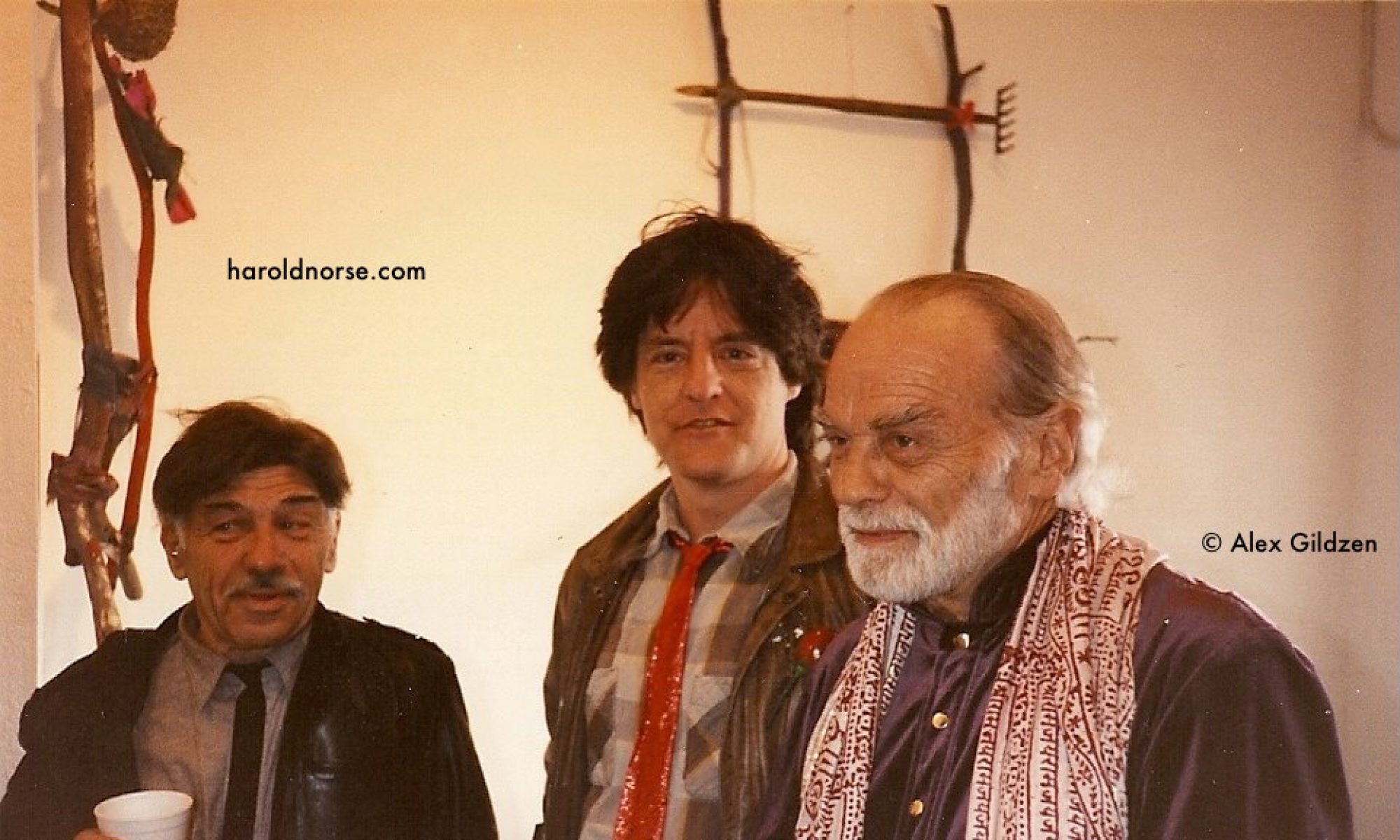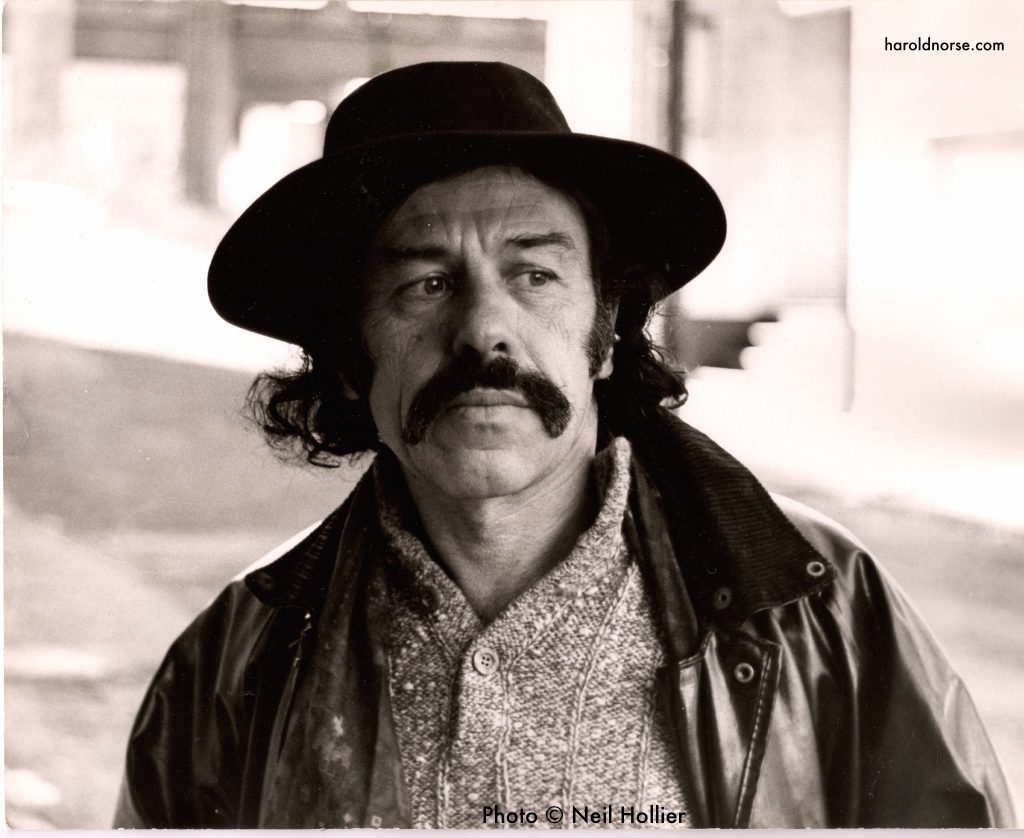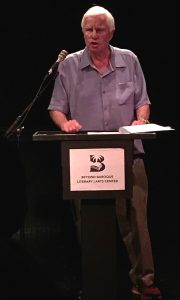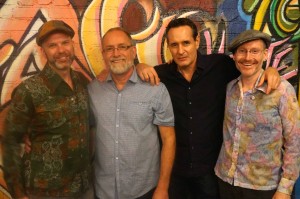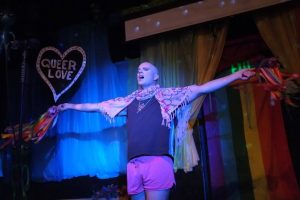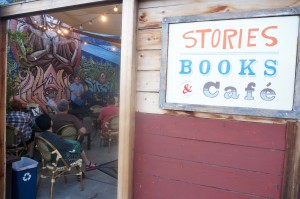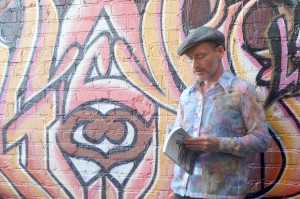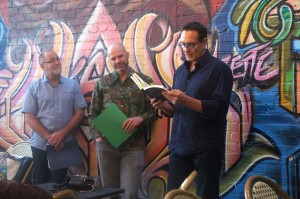Today marks the 101st birthday of Harold Norse whose gutsy and ground breaking poetry in the American vernacular continues to inspire and inform generations of readers. Last year there were a series of events celebrating the centennial of the Bastard Angel from Brooklyn. In this post, we’ll look back at the final Harold Norse 100 event held at Beyond Baroque in Venice Beach, where Norse had lived upon his return to the States in 1968 after fifteen years abroad.
The evening featured remembrances by one of Harold’s oldest friends complemented by interpretations of his poetry by two local L.A. performers. That evening the SoCal skyline was but a hazy layer of smoke and ash from a raging wildfire north of the city, but it didn’t deter a small yet dedicated audience from attending a truly special event.
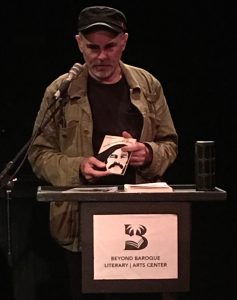 For decades Beyond Baroque has been a space where performance and creation of new works has remained available to a wide variety of artists. (They celebrate their 50th anniversary next year.) It’s bookstore has a superb collection of poetry titles, including a number of Harold Norse’s books which are out of print.
For decades Beyond Baroque has been a space where performance and creation of new works has remained available to a wide variety of artists. (They celebrate their 50th anniversary next year.) It’s bookstore has a superb collection of poetry titles, including a number of Harold Norse’s books which are out of print.
Richard Modiano, Director of Beyond Baroque, has long been a supporter of Norse’s work. In 2015, they held a reading for the release of Norse’s selected poems, the first posthumous collection of his poetry.
Jason Jenn’s dedication to keeping alive the legacies of ground breaking gay artists from the 20th century are part of his gifted talent of inspiration and information. Following his participation in the two San Francisco centennial events, Jason was on his home turf at Beyond Baroque. Among the poems he chose for that evening’s performance was “California Will Sink“, written while Harold was living in Venice Beach in the early 1970s.

A work of both hopelessness and regeneration, it interweaves the poet’s initial attempts at restoring his health after decades of cigarettes, booze and boys with an awareness of society’s destruction of the environment and its effects on animals. Further analysis of the poem, and the political perspective in Norse’s poetry, can be read in an essay I wrote for Beatdom.
 Longtime Los Angeleno, S.A. Griffin, profiled in a previous post, has been acting and writing for decades. His unique talents were in fine form that evening with a reading from Griffin’s own cut up of Norse’s writing prepared specially for the event.
Longtime Los Angeleno, S.A. Griffin, profiled in a previous post, has been acting and writing for decades. His unique talents were in fine form that evening with a reading from Griffin’s own cut up of Norse’s writing prepared specially for the event.
The cut up method was first developed in the early 1960s at the Beat Hotel where Norse collaborated with William Burroughs and Brion Gysin by physically cutting up text, inserting the element of chance. The rearranged text often resulted in startling new works.
The group’s experimentation continued through the manipulation of tape recorders and into visual art. Harold made what he called Cosmographs by throwing colored ink onto paper which was then rinsed out in a bidet. The vibrantly colorful works, which looked towards the forthcoming psychedelic movement, were recently featured in an anthology The Outlaw Bible of American Art.
For this final centennial celebration, Griffin chose his cuts from a number of Norse’s best known poems including “I’m Not a Man” and “Classic Frieze in a Garage” and adding “Sniffing Keyholes”, the centerpiece to Norse’s novella Beat Hotel, the only cut up book written entirely at the famed hotel. Griffin’s piece, strong and engaging, brings refreshed perspective to Norse’s work, suitably evocative for a hundredth birthday celebration.
Writer Tom Livingston’s friendship with Norse was previously examined in this post. In 1961, when his first novel had been accepted by Bantam Books, Livingston was living in Palo Alto. Long before its transformation into the immense wealth of Silicon Valley, Palo Alto was still a small town.
It was on a nondescript country street named Perry Lane where the poets and novelists hung out. Ken Kesey lived there while finishing One Flew Over the Cuckoo’s Nest and the gay English poet Thom Gunn was a teaching assistant as Stanford.
Once Tom’s advance money came in, he flipped a coin to decide whether to travel to Tahiti or Paris. It came up heads for Paris. It was through a friend from Palo Alto named Mike Miller that Tom first heard about Harold Norse when New York Times columnist Anatole Broyard invited them to visit the Beat Hotel and meet the expatriate poet.

They first met at the café Deux Magots where Norse offered Livingston a job with the Living Theater who were performing two plays as part of France’s Theater of Nations summer series. Their friendship further developed when Norse learned that Livingston knew Henry Miller. Among Norse’s mentors from his time in New York City was the writer Anaïs Nin who had a long love affair with Miller.
Livingston had played ping pong with the Brooklyn born writer’s sons in Big Sur when Livingston had worked as a bartender and chambermaid at what later became the Esalen Institute. Norse revealed that a New York friend named Harry Herskovitz had entrusted him with two boxes of about 500 letters from Miller which had mysteriously disappeared. The loss of correspondence and manuscripts became a reoccurring theme in Norse’s life.
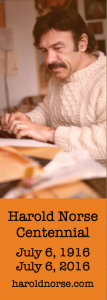 While discussing this mutual association in Norse’s tiny room at the hotel, Livingston suddenly felt a paralyzing chill from the back of his neck down to base of his spine. “Bill is giving you his death ray,” Harold said. Turning towards the doorway, Livingston saw William Burroughs in a three-piece suit, one hand holding an unopened umbrella, who turned away and called “Ian…Ian…it’s time for dinner.” Ian Sommerville was Burroughs’ lover, who helped him get off heroin while also contributing to the development of Cut Ups.
While discussing this mutual association in Norse’s tiny room at the hotel, Livingston suddenly felt a paralyzing chill from the back of his neck down to base of his spine. “Bill is giving you his death ray,” Harold said. Turning towards the doorway, Livingston saw William Burroughs in a three-piece suit, one hand holding an unopened umbrella, who turned away and called “Ian…Ian…it’s time for dinner.” Ian Sommerville was Burroughs’ lover, who helped him get off heroin while also contributing to the development of Cut Ups.
These are but a few of the stories relayed by Livingston; for more of his fantastic talk, take a look at the video link above.
As the evening ended, we drifted out into the nighttime sky whose setting sun glowed red from the still burning Sand Fire. It’s unearthly glow prompted me to recall the final lines from one of Harold’s greatest poems, “I Am in the Hub of the Fiery Force”
obsessed with red as the universe burns
i am in the hub of the fiery force
the red heat of the conflagration
o cosmos turn! turn! thy flaming wheel!
